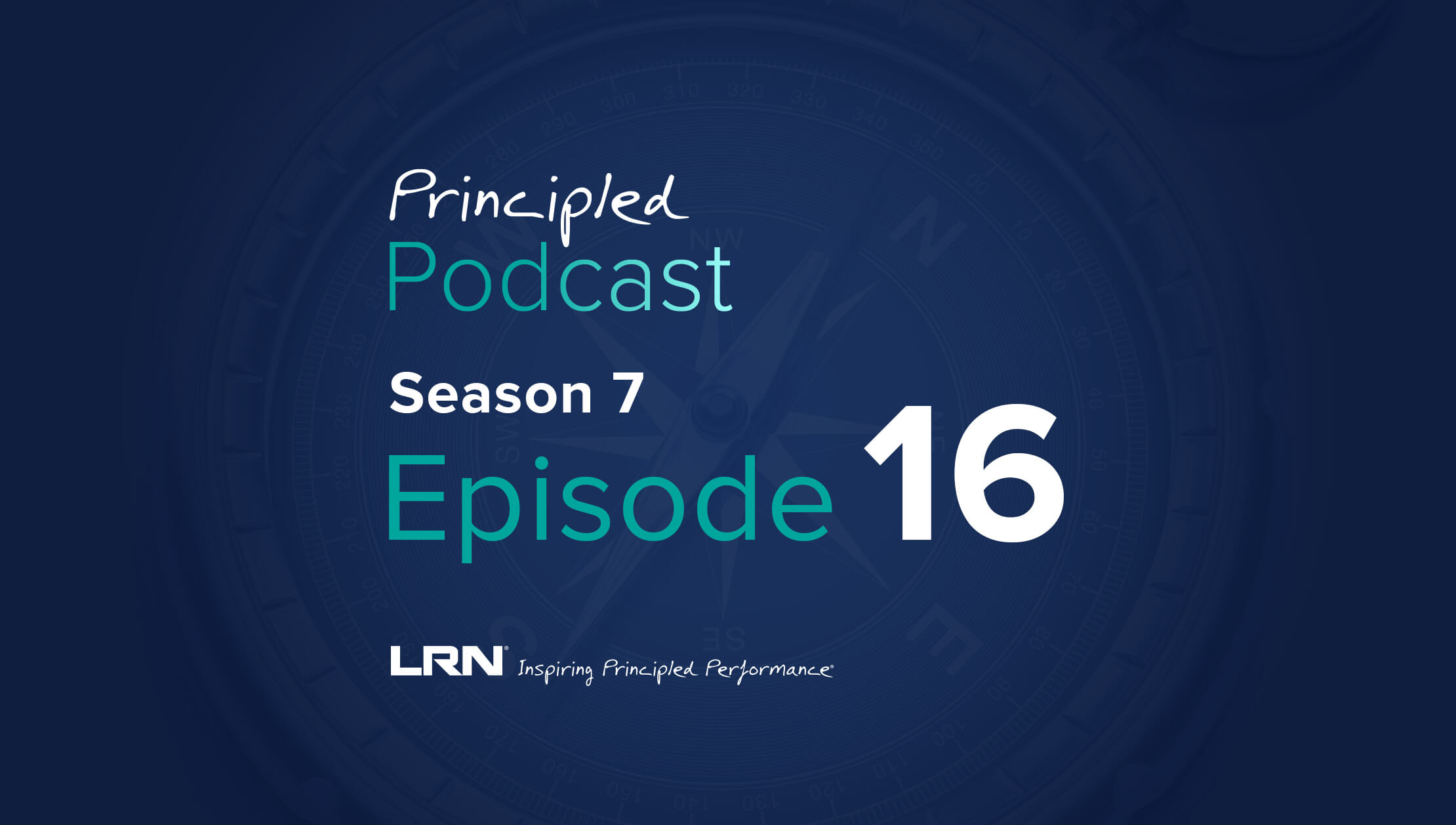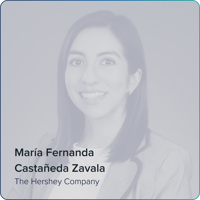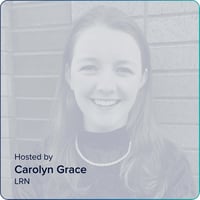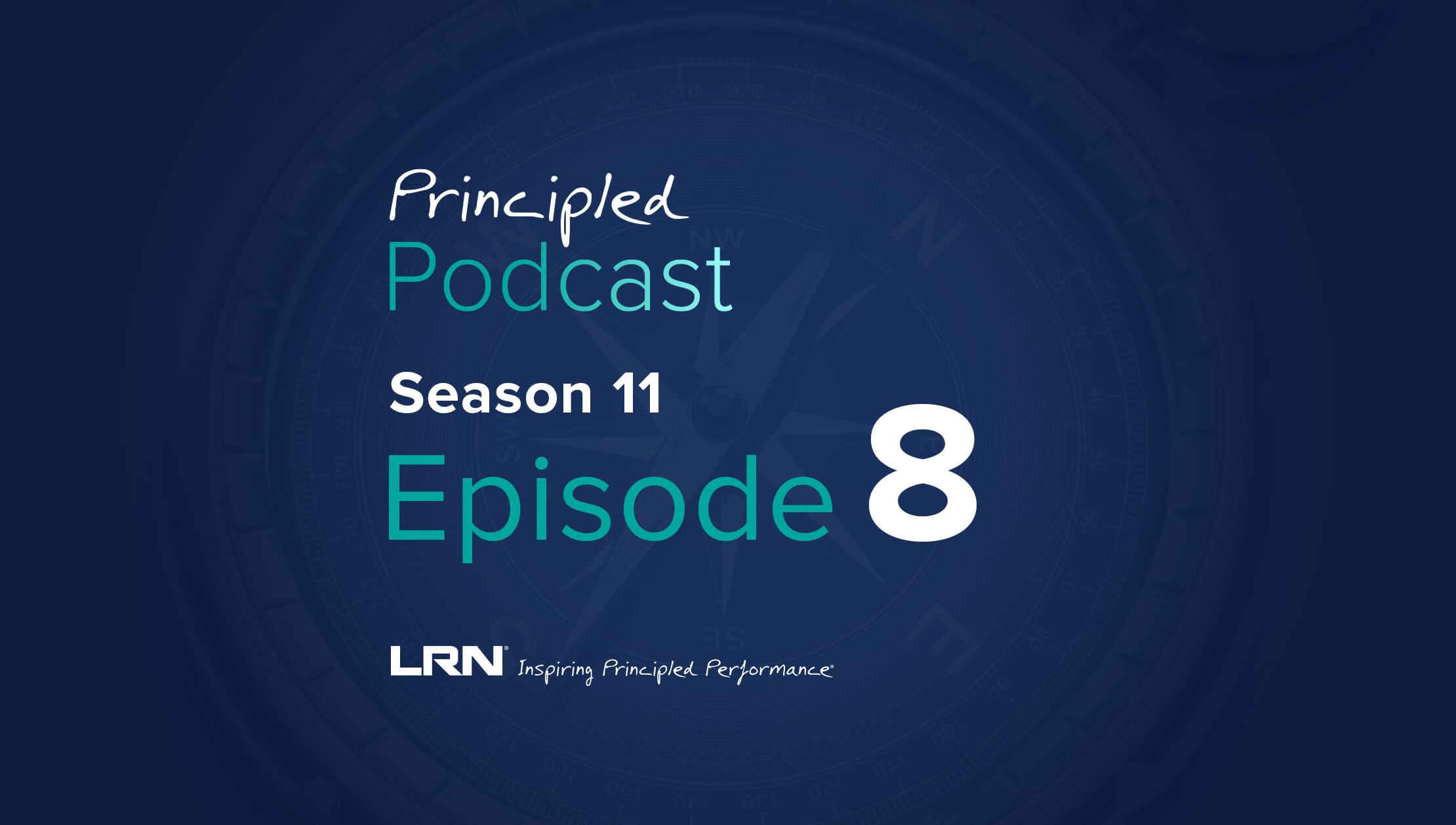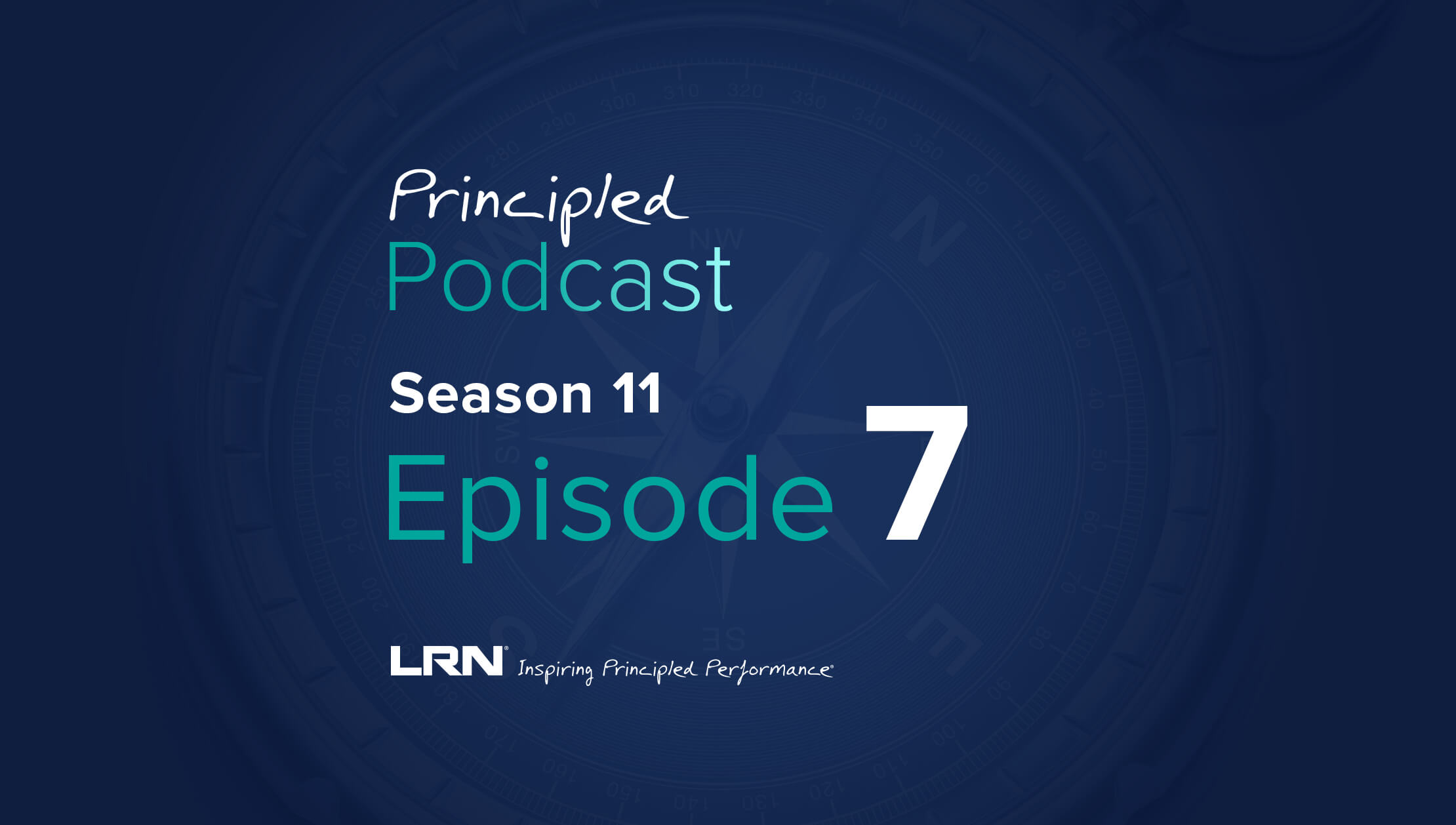What you'll learn on this podcast episode
According to LRN’s 2022 E&C Program Effectiveness Report, 56% of the respondents said that integrating major program elements into a mobile app was a high priority for them this year. But what does a “good” mobile solution look like? And how can you ensure it strikes the right balance of meeting compliance needs while creating an engaging—and helpful—user experience? In this episode of LRN’s Principled Podcast, Carolyn Grace, content writer and podcast co-producer, discusses E&C mobile solutions with María Fernanda Castañeda Zavala, the ethics and compliance manager at Hershey. Listen in as they explore how Hershey leveraged a mobile app to enhance the components, capabilities, and overall brand of their E&C program.
Where to stream
Be sure to subscribe to the Principled Podcast wherever you get your podcasts.
Guest: María Fernanda Castañeda Zavala
María Fernanda Castañeda Zavala serves as the Ethics and Compliance Manager for The Hershey Company. She is responsible for driving the ethics and compliance program effectiveness and awareness across the company. She leads the implementation of training, communications & outreach, policy lifecycle management, monitoring, case management, and co-leads Hershey's Ambassador program.
Prior to joining Hershey, she was Ethics and Compliance Analytics Program Manager at Nokia, where she led initiatives to collect, analyze and visualize data to test compliance controls, enabling data-driven decisions to drive continuous program improvements.
She holds a Master of Business Administration degree from Montclair State University, New Jersey, and an Accounting bachelor's degree from Escuela Bancaria y Comercial, Mexico. She is a Certified Compliance and Ethics Professional-International (CCEP-I) and a Certified Business Analyst.
Carolyn Grace is a content writer on LRN's global marketing team and co-producer of the Principled Podcast. She specializes in writing compelling stories about ethics and compliance that resonate across business segments, industries, and personas while hitting critical KPIs for traffic and engagement. Topics she frequently covers include ESG, data privacy and protection, DEI, the role of boards of directors and leadership, corporate training and e-learning, and ethical corporate culture.
Prior to joining LRN, Carolyn was a writer and content strategist at Thinkso Creative, a boutique creative agency in New York City. At Thinkso, she wrote internal and external communications for clients in technology, nonprofit, law, logistics, and financial services sectors. Before that, Carolyn conducted trend research and cultural strategy at Horizon Media, specializing in entertainment, travel, media and technology, health and wellness, and food and beverage categories. Carolyn graduated magna cum laude from the University of Pennsylvania with a B.A. in American History and French Studies and a minor in Journalism.
Principled Podcast Transcription
Intro: Welcome to the Principled Podcast brought to you by LRN. The Principled Podcast brings together the collective wisdom on ethics, business and compliance, transformative stories of leadership and inspiring workplace culture. Listen in to discover valuable strategies from our community of business leaders and workplace change-makers.
Carolyn Grace: If you want your ethics and compliance program to meet your employees where they are, you need to take mobile seriously. And most E&C professionals know that. In fact, 56% of the respondents to LRN's 2022 E&C Program Effectiveness Report said that integrating major program elements into a mobile app was a high priority for them this year. But what does a good mobile solution even look like, and how can you ensure it strikes the right balance of meeting compliance needs while creating an engaging and helpful user experience?
Hello, and welcome to another episode of LRN's Principled Podcast. I'm your host, Carolyn Grace, content writer and co-producer of the podcast at LRN. Today. I'm joined by María Fernanda Castañeda Zavala, the ethics and compliance manager at Hershey. We're going to be talking about how Hershey leveraged a mobile app to enhance the components, capabilities, and overall brand of their E&C program. Fernanda is a real expert in this space with a background focused on compliance analytics and monitoring. Fernanda, thanks for coming on the Principled Podcast.
María Fernanda Castañeda Zavala: Thank you for having me, Carolyn. I'm glad to be here talking about our journey and our ethics and compliance program.
Carolyn Grace: I've really been looking forward to this conversation with you as I've been hearing nothing but success stories coming out of Hershey's mobile E&C solution. For those who aren't as familiar with your story, can you start by sharing what Hershey's ethics and compliance program was like before the app came along? What were the challenges or opportunities you wanted to address at the time?
María Fernanda Castañeda Zavala: Certainly Caroline. Well, at Hershey, we are a purpose driven organization and our ethics and compliance program is designed to promote an organizational culture that encourages ethical behaviors and lives our shared values of togetherness making a difference, excellence, and of course, integrity. Our program overall is guided by a suit of carefully crafted policies and processes developed to keep us competitive, prepared and resilient. Back in 2020 and motivated by the 2020 DOJ compliance guidance, one of our priorities in the program was to understand how our colleagues were interacting with our set of policies, our code of conduct and general information that we were putting together around our program. Our goal was to be able to measure our program effectiveness. So various data points to identifying trends, patterns, KPIs, or potential gaps.
At that point, we used to have our policy library on the internet and had the limitation that we weren't able to get any insights on the number of views or searches in the code or our policies. We were looking to streamline the process to providing training, access to our concern line, that's the way we call in Hershey, our helpline, our code of conduct and overall, the policy information. That is when we thought about having all in one place that could allow us to have metrics and provide all resources in a consolidated way. We were conscious that we wanted to do it in a way that allow our colleagues to get our information in easy to access way and ideally, on the go. We know that a good part of our workforce is not in front of a computer the whole time. And we're looking to ensure they have the support needed at their fingertips, an easy way to ask for help when required. That is when we realized a mobile app with the correct capabilities would allow us to achieve this goal. And we did our research and start working toward this objective.
Carolyn Grace: That makes a ton of sense. I think, especially hearing you talk about the ease of access and being on the go, we are in a 21st century workforce. There's no surprise there that many people are away from desktops and laptops and using their mobile devices. So your logic behind building this program into a mobile app makes a ton of sense. So let's talk about the mobile solution itself. What did you ultimately build into your E&C app and what was your reasoning behind choosing those particular elements to achieve the objectives that you were just talking about?
María Fernanda Castañeda Zavala: Perfect, yes. So as I said, we wanted to monitor our effectiveness. So our goal was to have one stop shop for ethics and compliance needs. That is why we focused on some elements that were core to our program and we wanted to make sure all of them were included in our app. Those elements are our code of conduct, our policy library, our reference guide library, or job aid library. We needed to have a direct access to our concern line and either access to our learning management system to allow our colleagues to complete their trainings on ethics and compliance, or any training overall throughout the app. And we also wanted to have a direct access to our monitoring processes, like for example, disclose a conflict or any of the processes that we have in place in the program.
We were able to design an app that is user friendly, easy to navigate and where employees can find the content in their local language. That was also an important inclusion aspect that we wanted to ensure in the app. As an example, the code of conduct is organized by section. So the end user is able to go directly to the area of interest or search on any specific content. Let's say, if I am looking to understand the company's stand on retaliation, I can go to the specific area or search by the term and the app will provide me all the resources available around that topic. Our user interface is set up in English, but the end user can select the language they want to see the content in. So we have that flexibility built in, in the app. For example, if a colleague based in Mexico will like to see all the content in Spanish, they are able to do so, selecting their preferred language and the content in the language is automatically showed.
For us, it was important to include languages, to empower all employees to have the and compliance information in their fingertips. The app also helped us to consolidate in one place, all monitoring processes, as I said, that we have in place. Our colleagues don't need to look around in the internet or different portals to find where to disclose a potential conflict, where to declare some hospitality or any of our processes. They can get into the app and find the proper links there.
The app is also a way to facilitate access to our LMS. Our colleagues can complete their trainings from their mobile phones or tablets. These greatly benefits employees that are not in front of a computer all the time, as we just highlighted. Overall, one of our main objectives was to measure program effectiveness. And with analytics available on app usage, we are able to identify what areas of the code most are most the most viewed, the terms most search. So we are able to take action and draw out campaigns or produce content that answers the questions that are being asked. It is important for us to highlight that, although we do analytics in the app usage, we do not connect any consumer or customer data. The app is designed to host our library. And the only information we get is a number of view and search terms. That is enough to give us visibility on the data we wanted to see, to understand our content impact.
Carolyn Grace: That is a really great clarification point for sure. And I love that I'm hearing all of these elements of personalization that you have really built into this app. Not only in terms of languages that people can engage in with this content, but also the actual content itself that they are engaging with. One of the things that always interests me about mobile app development as well is the branding, and how organizations really lean into making the app their own. I'm curious, what were some things that Hershey did to help make the app look and feel connected to the wider company?
María Fernanda Castañeda Zavala: I think that you hit a very important point. Branding is important when you are developing your app or customizing your app. That is why the first thing that we did during the development of the app is sharing our company visual guidelines. We connected with our communications team and they provided the color codes and imagery that will ensure Hershey look and feel within the app. Our company already has other apps for different purposes. That is why we wanted to provide a similar experience in the ethics and compliance app.
The next step that we took is it was to define the name of the app itself. For that purpose, we also wanted collaboration. Therefore, we asked for the help of our peers and we launch an internal survey asking for suggestion on the title of the app. And we received a variety of creative names, but we selected five that resonated the most.
And the selection went then into a poll, where we asked for votes and the winner was selected, and our app it's called iComply. Once we had the name, we went back to our talented corporate communication designer, and she came up with our app logo, which matches our program brand and is aligned with our corporate visual guidelines. The development team in LRN made further customizations to make the app feel in line with our brand, delivering consistent brand identity across the wider organization. It was without doubt, a very collaborative process and we needed to relay a lot in our internal resources to have the proper branding within the app.
Carolyn Grace: That's great. And I love that you went to the people of Hershey to really get involved in this process and contribute to what ultimately became the brand of your ethics and compliance program. I think that only speaks to the even bigger importance of a company's brand, it's made up of the people who work there. So I love that particular element of your process. So I'm sure at this point, our listeners are now eager to know what the impact of all of this has been. What are some interesting results that you've seen, quantitative or qualitative, since adopting this mobile app?
María Fernanda Castañeda Zavala: Well, right after the implementation, we got a very positive reactions from our leadership, our colleagues, and our compliance ambassador network. From a quantitative perspective, we saw a very good adoption rate in our workforce. 40% of our corporate employees reviewed the app and it's content at least one time in the first six months, after the implementation. We compared this with other companies within the industry and it came out to be a very good adoption rate, ratifying that having all resources in one place was a real necessity. We were able to identify that our reference guides or job aids were the contact consulted the most. So that informed our decision on how to best convey our compliance guidelines to our colleagues.
We now understand that another important part is the use of notifications. The app enable us to send a short message to all our users, reminding them of the important aspects of the program, or invite leaders to discuss videos or reference guides with their teams that we have available in the app. And appropriate use of notifications, I must say, allows you to drive adoption, maintain awareness, engagement, and send tailored messages to your teams.
As the use progressed, we identified areas that we needed to include in the app. For example, we were able to connect our legal chatbot to the app. Now, employees can navigate in the app and get redirected to the chatbot and get the immediate assistance they require. One of the other comments that we got right at the beginning was that the app needed to be available for tablets. So we raised that right away to the developer. And now we have the app available in that format too.
Carolyn Grace: That's fantastic. And I mean, wow, what an adoption rate for your app. I have spoken with a member of LRN's mobile development team on a prior episode of this podcast, actually, and we were talking about adoption rates. So to hear that it was 40% is just incredible. And again, to hear that you were taking direct feedback from employees using the app to further iterate on the development is just really exciting to hear. It sounds like this was a highly iterative process, which I am sure is just another day in the life for ethics and compliance program managers like yourself. What are some key insights you learned from this work and how can they inform the way E&C professionals should approach mobile?
María Fernanda Castañeda Zavala: That's a great question. I think that overall, planning is key. And you first need to understand your needs and set goals that align with them. If you have, for example, a workforce that's on the go and do not have a computer all the time in front of them, you may want to consider having a mobile option for them. Once you have clarity on what you're looking to achieve, do your research. And building an app might seem a big challenge, but if you have a clear idea of what you want to include and what are the pain areas you want to ease with an app, the task will be easier. As I said, planning is key.
When developing our app, we made a list of areas that we wanted to cover. We collaborated with our IT team to ensure we will be able to connect our LMS and the security required within the app. We brought our communication team, as shared before, in the planning stage to ensure we had the correct branding. We talked with our HR team to make sure we included the the correct policies in the app. And at the end, it was a cross functional collaboration. And I would say that's another key area, cross functional collaboration is key. That collaboration also paid off when we look to connect our chatbot. IT has been a key partner to help us make that happen.
Another important area that we might consider is simplicity and user friendly. These are other key components to consider. If you decide to have an app, it should be easy for the end user to navigate and explore the content. That will help to ensure engagement with the users and secure awareness. You also have to consider to be agile in the process. In our program, we strive to keep relevant content in the app, make regular reviews of your content to make sure it still serves your purposes and update it as necessary. That will make sure that you send notifications about the changes or the updates and it will ensure that users are engaged and are really checking and reviewing the content in-app.
Carolyn Grace: That makes a ton of sense. And I think what you just mentioned about simplicity is so essential here. You and I, and so many of our listeners are using mobile apps every day, and it's no surprise that the ones we don't use as frequently tend to be ones that are too complex. And with something like an ethics and compliance program, I'm sure it can be very easy to want to put everything in there. But that cross-functional collaboration that you were just talking about I'm sure is what ultimately helps figure out, okay, what is the most essential pieces of information and features that we need to get that program message across and to ensure that is as effective as possible? So I think that's a really great point to make.
I mentioned at the top of our episode, that one of the key findings from our 2022 E&C Program Effectiveness Report was that more than half of respondents said integrating major E&C program elements into a mobile app was a high priority for their program in the near future. What recommendations would you give to those folks who are just starting out with this?
María Fernanda Castañeda Zavala: I would say that similar to what, what I shared before planning is key and knowing your program is key. Ethics and compliance tends to be a complex area, where you need to convey messages in an easy way for employees to adapt and understand and follow. So if you want to have an app that your colleagues will use, definitely you have to make it simple and have to make the content engaging enough so people go back and see the usefulness of the app. Having a mobile option for all employees to consult policies and procedures, I think it's a great advantage that must be considered. Before we were recording this podcast, PR came to me and mentioned that she normally, when she has some hesitation about a procedure or a process, she normally goes to the app and quickly reviews the section that she needs to clarify and find it easy and really fast way to just check one or two points on the go.
So I think that if that's something that you're willing to achieve, explore the possibility of having the app. Do not be afraid that it's going to be a complex situation, but do make a plan. And also consider that if you want to have an mobile application for your ethics and compliance program, that this application, it's part of your communications calendar or your overall year strategy. When you combine campaigns that you do with the trainings and you send notifications throughout the app that all, the whole experience or the whole idea, it's very cohesive and allows employees to have an overall idea of the environment and the usefulness of the app.
So have that in mind whenever you want to explore the possibility of mobile app. And then again, simplicity, be agile, look for a functionality that allows you to update the information that you have there quickly and in an easy way so that it does not turn out to be cumbersome for you being updating the information in that app. That would be my main recommendations because I think it's a great option and a great tool that ethics and compliance programs can leverage from.
Carolyn Grace: Absolutely. And you make such a great point, that ease of use in the app is not just for the end users. It is for the program managers and it and admins who are putting material in the app as well. So all the more reason to keep it simple and streamline the process as much as you can. That communications aspect as well, I think is a great point to highlight for folks because to your point, ethics and compliance programs are so much more than training or just the code of conduct, it really is about the whole experience of the program. And so highlighting the use of notifications, I think is a great point when it comes to communicating key elements of your program. Fernanda, I think that we could go on and on and on about the importance of mobile apps to E&C programs, but unfortunately we are out of time today. But thank you so much for sharing these insights with me and keep up the great work at Hershey.
María Fernanda Castañeda Zavala: Thank you so much. I think you're right, we could go on and talk for a long time. But thank you for having me and for this opportunity to share our journey and lessons learned.
Carolyn Grace: Yes, absolutely. And thank you all for listening. You can learn more about the importance of mobile solutions by downloading a copy of the 2022 Ethics and Compliance Program Effectiveness Report at LRN.com, or by clicking the link in our show notes. I'm Carolyn Grace, and we'll see you next week on the Principled Podcast.
Outro; We hope you enjoyed this episode. The Principled Podcast is brought to you by LRN. At LRN, our mission is to inspire principled performance in global organizations, by helping them foster winning, ethical cultures rooted in sustainable values. Please visit us at LRN.com to learn more. And if you enjoyed this episode, subscribe to our podcast on Apple Podcasts, Stitcher, Google Podcasts, or wherever you listen. And don't forget to leave us a review.
Be sure to subscribe to the Principled Podcast wherever you get your podcasts.
